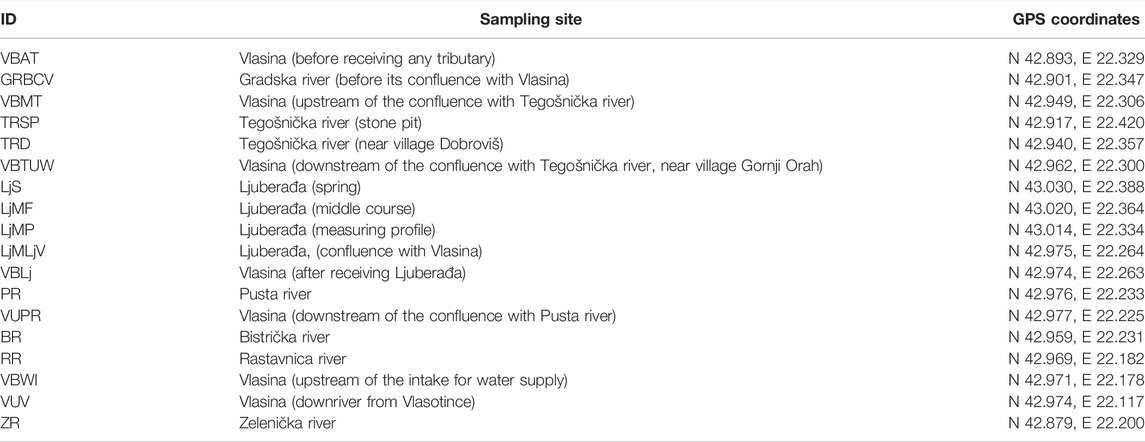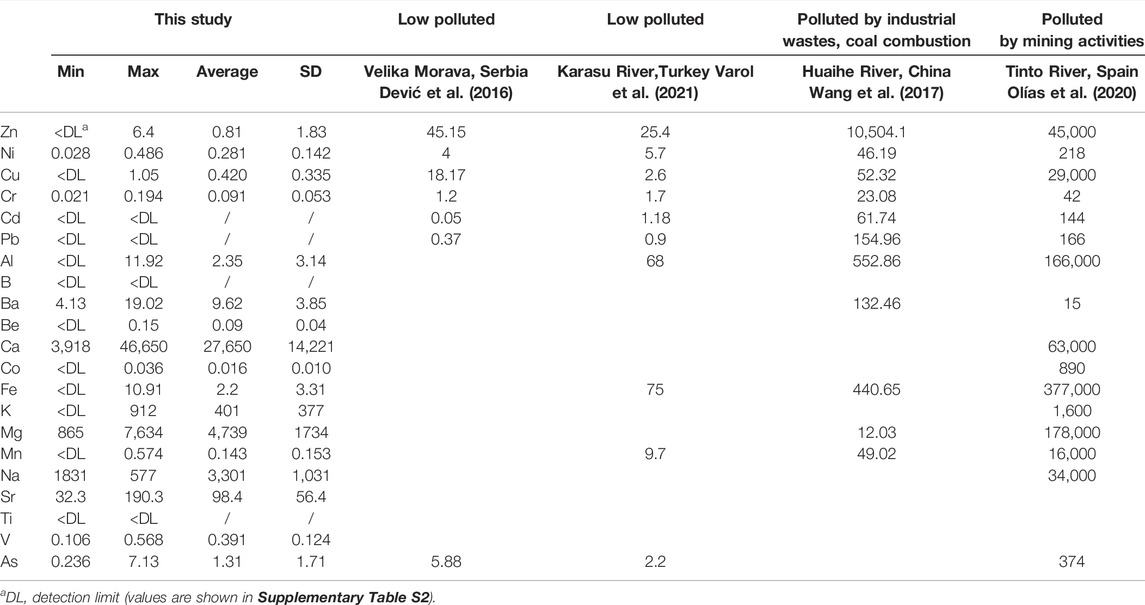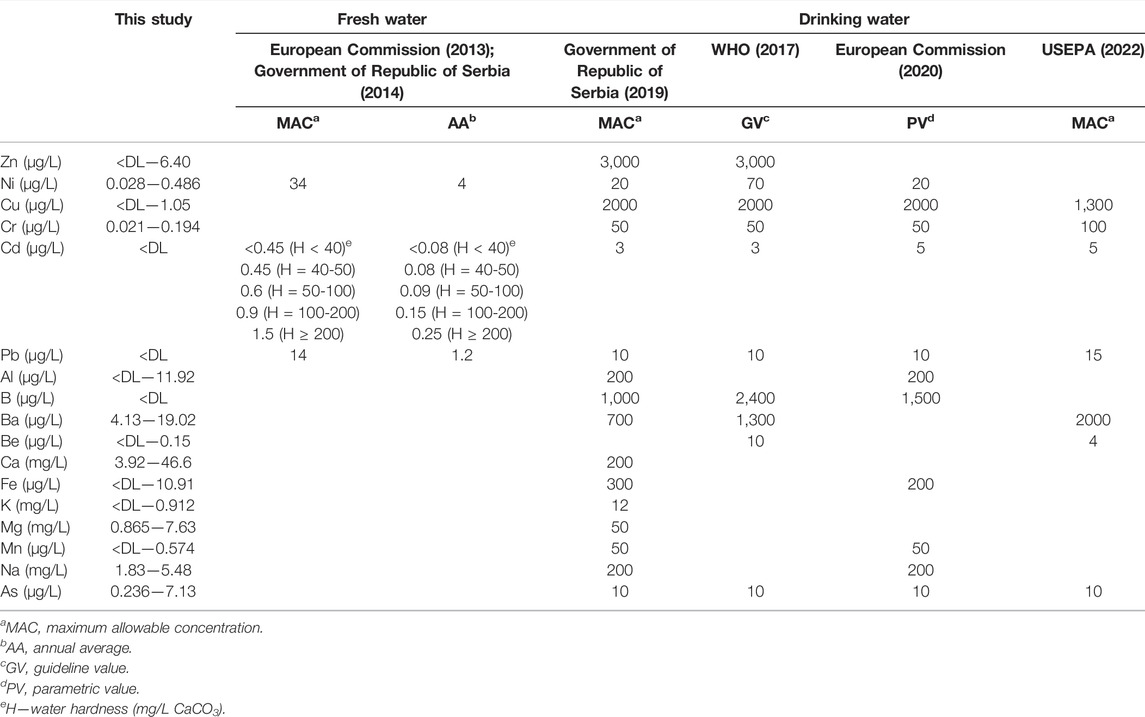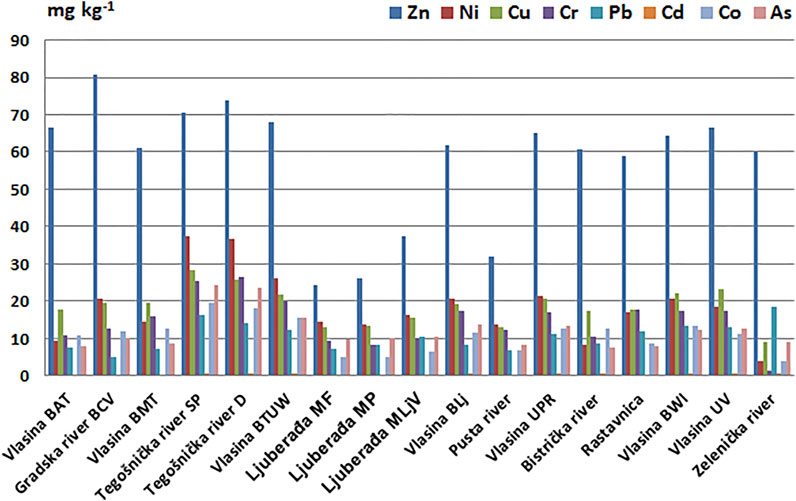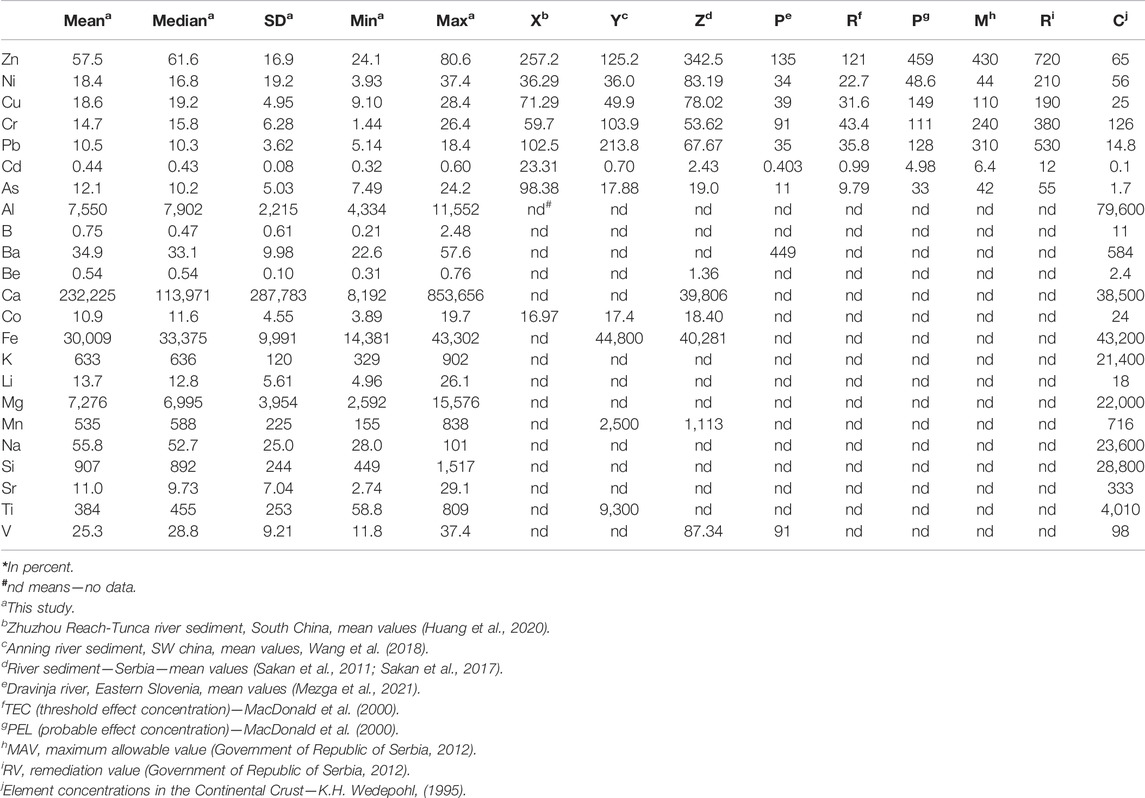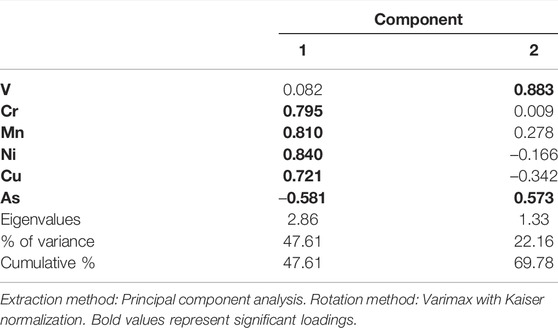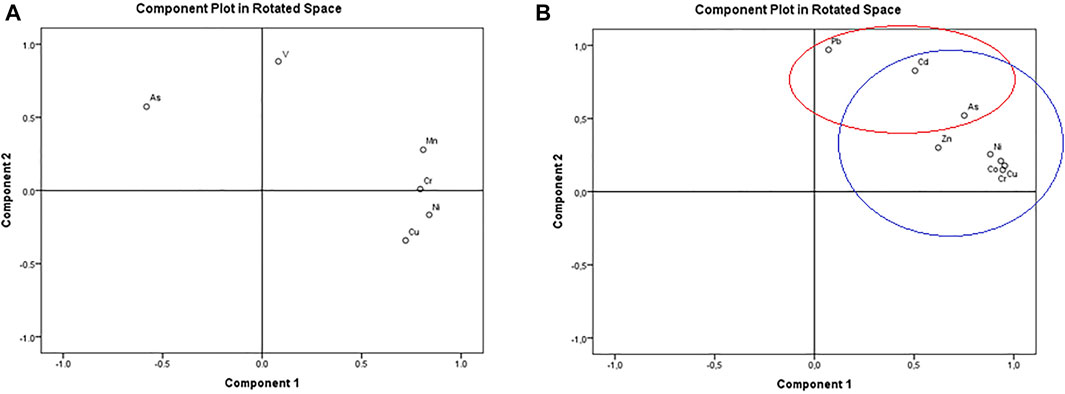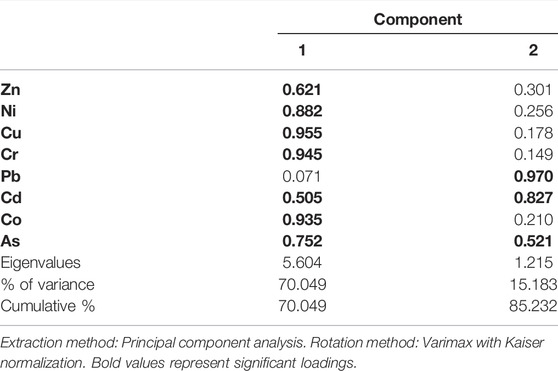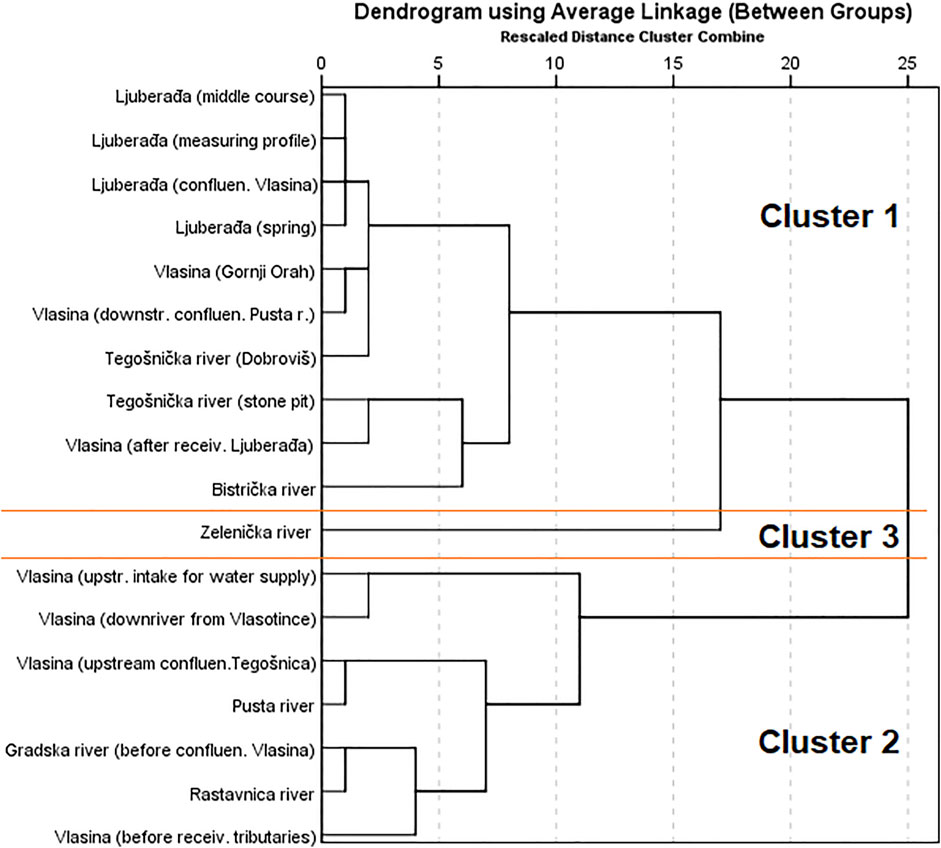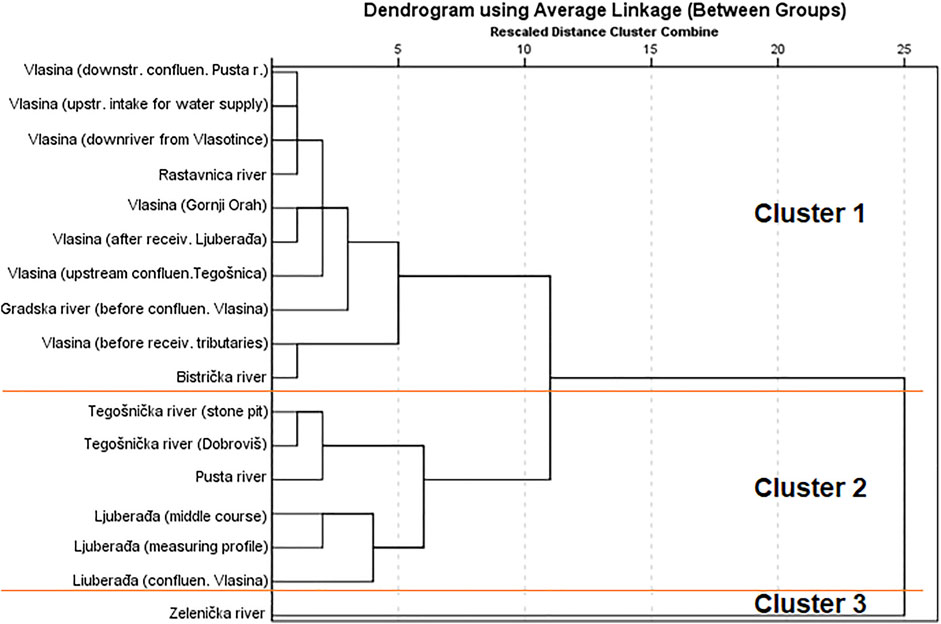- 1Centre of Excellence in Environmental Chemistry and Engineering, Institute of Chemistry, Technology and Metallurgy, University of Belgrade, Belgrade, Serbia
- 2Faculty of Chemistry, University of Belgrade, Belgrade, Serbia
- 3Ruđer Bošković Institute, Division for Marine and Environmental Research, Zagreb, Croatia
Increasing pollutant levels in surface water are a very important problem in developing countries. In Serbia, the largest rivers are transboundary rivers that cross the border already polluted. Taking this into account, evaluation of the distribution characteristics, ecological risk, and sources of toxic elements in river water and surface sediments in the watercourses of the Vlasina watershed is of great significance for the protection of water resources in Serbia. A total of 17 sediment and 18 water samples were collected and analyzed by Inductively Coupled Plasma—Optical Emission spectrometry (ICP-OES) and Inductively Coupled Plasma—Mass spectrometry (ICP-MS) to determine micro- and macroelements contents. The geo-accumulation index (Igeo) was applied to determine and classify the magnitude of toxic element pollution in this river sediment. The contents of the studied toxic elements were below water and sediment quality guidelines. For studied river water, results of principal component analysis (PCA) indicated the difference in behavior of Cr, Mn, Ni, Cu, and As and V, respectively. Cluster analysis (CA) classified water samples according to As and Cu content. The PCA results revealed that lead in river sediments had different behavior than other elements and can be associated mainly with anthropogenic sources. According to the degree of Igeo, the majority of sediments in the Vlasina region were uncontaminated regarding studied toxic elements. The origin of elements is mostly from natural processes such as soil and rock weathering.
Introduction
The sediment environmental compartment is a heterogeneous natural matrix of materials (Carrillo et al., 2021). Unfortunately, great pollution of rivers and sediments has been noticed recently. Monitoring of sediment contaminants and assessment of sediment quality is usually carried out with the objectives of determining the extent to which the sediments are either a source or a sink for contaminants and evaluating the effects of these contaminants on the environment of the investigated water body. Bearing this in mind, analysis of sediments provides an efficient tool for water-quality management. There are numerous challenges in the management of contaminated sediments, and there are no easy solutions.
Anthropogenic activities have increased the concentrations of pollutants in our environment. One of the significant pollutants are potentially toxic elements (PTEs), and they can easily bind to sediments. The majority of toxic elements are quickly deposited in the sediment after entering rivers, and their concentration in the sediment is much higher than in the water body of riverine systems (Huang et al., 2020). The trace elements can be toxic at high concentrations. Due to their resistance to degradation, trace elements could continue to exist in the environment for a long time (Haris et al., 2017). Since trace elements are not biodegradable, they have a hazardous effect on the ecological balance in aquatic ecosystems (Baran et al., 2019). Toxic elements in the environment can be of natural, geogenic origin, such as rock weathering with subsequent dissolution of metals in rivers (Looi et al., 2013). Still, the portions of metal emitted by natural processes such as volatilization, deposition from mineral rock, and weathering of bedrock are small (Rodríguez et al., 2015). Sediments do not permanently binds metal although they are some of the endmost sinks for metals input into the aquatic environment (Jahan and Strezov, 2018). Since remobilization can happen long after the initial input, it is essential to understand the toxic properties of contaminants in order to assess the risks associated with contamination.
For the identification of pollution problems, it is necessary to distinguish anthropogenic contributions from natural sources. In the past few years, applying pollution index-based approaches (contamination factor, enrichment factor, geoaccumulation index, toxic risk index, pollution load index, potential ecological risk, biogeochemical index, etc.) and multivariate statistical methods (cluster analysis, principal component analysis, factor analysis, and discriminant analysis) in riverine environments has become a very important and significant combination of methods in assessing the degree of pollution (Radomirović et al., 2021). Chemometric methods are statistical analyses of measured data, but pollution indexes are used for quantification of pollution and they are calculated as ratios of measured and background contents of elements. Pollution indices are widely considered as tools to quantify the degree of total metal pollution and assess the ecological risk of metals in sediments and soils (Ustaoğlu et al., 2020; Ustaoğlu and Islam, 2020; Carrillo et al., 2021; Ustaoğlu 2021; Yüksel et al., 2021). Multivariate statistical approaches have been successfully used in environmental studies to identify the interrelationships between the measured data (Sakan et al., 2009; Thuong et al., 2013; Mihajlidi-Zelić et al., 2015; Dević et al., 2016; Varol et al., 2021), in order to detect sources of pollution and relationships between sampling sites and toxic element contents (Radomirović et al., 2020; Đorđević et al., 2021). Chemometric methods provide powerful tools for the modelling and interpretation of large, environmental, multivariate data sets generated within environmental monitoring programmes (Peré-Trepat et al., 2006) and, for that reason, are used in many studies.
Therefore, for a comprehensive evaluation of the quality of river sediments and quantification of pollution content, different methods should be integrated, and complementary approaches that combine sediment quality guidelines, geoaccumulation index, and statistical analysis should be applied. Since the river water system is dynamic with highly variable short- and long-term properties, analysis of sediment is very important in assessing the status of pollution in the river system.
In the previous period, accidental water pollution in Serbia was recorded (Sakan et al., 2009; Sakan et al., 2011; Dević et al., 2016), causing the destruction of wildlife in the watercourses. Taking into account that mountain rivers in Serbia are generally considered unpolluted, research involving an assessment of their ecochemical status and defining the degree of pollution would have great significance for Serbia as well as for the wider region.
In this manuscript, different approaches have been applied in the ecochemical study of the river sediments of Vlasina and the rivers in its basin. The objectives of this manuscript were to: 1) determine the distribution of micro- and macroelements; 2) assess the degree of contamination with PTEs using different methods; 3) identify the interrelationships between the studied elements and localities; and 4) identify possible sources of pollution using chemometric methods. Since this type of research has not been done in the investigated area so far, the obtained data will be of great importance both for researchers engaged in the research of river systems and the population living in this area.
Materials and Methods
Site Description
Vlasina is a river in southeastern Serbia. The spring is below the Vlasina lake dam. The most important tributaries are: Lužnica (Ljuberađa), the Tegošnička River and the Pusta River. Other tributaries are the Gradska River and the Bistrička River. The length of Vlasina is about 70 km, and eventually it flows into the South Morava as a right tributary, 10 km downstream from Vlasotince. Because of its mountain environment and because of the lack of industrial polluters, Vlasina is considered one of the cleanest rivers in Serbia. In recent years, in the surroundings of Vlasina basin, some anthropogenic emission sources have appeared, which can change the environmental status of this basin. For example, foreign investors are planning to open several mines upstream (Crna Trava, Čemernik) and it is very important to know the history of Vlasina basin water pollution.
The pedological composition of the territory of Vlasina is characterized by diversity, although due to the influence of pedogenic factors (rocks, vegetation, climate, and water), a certain zonation in the distribution of land is observed (Marjanović 2000). The area of Vlasina is characterized by exceptional biodiversity and autochthonous biosystems. Climatic factors, as well as geological, geomorphological, and pedological characteristics of the terrain, lead to the development of interesting flora and fauna in this area. This entire area is covered by forests, degraded forests, pastures, and agricultural crops. In the Vlasotince plain, around the river Vlasina, river sediment—alluvial is rich in humus, and as such, it is suitable for growing agricultural crops. Fertile land, vast pastures, and a favorable climate provide good opportunities for agriculture (Savić, 2019). One of the main activities of the inhabitants of Vlasina is mountain agriculture: mountain cattle breeding—raising small (sheep) and large cattle (cattle and horses) and mountain agriculture—growing mountain cereals (rye, barley, and oats) and potatoes. Arable agricultural land of lower quality occupies a significant area: arable land dominates the hills, orchards are around the houses, meadows are on the slopes along forest belts and in the stream valleys (GLP 2012). On the slightly undulating and hilly terrain of the Vlasotinac vineyards, vertisol is widespread. Vlasotince is also the center of the wine-growing region (Čvoro and Golubović 2001). The branch of the economy that has been developing in recent years in this micro-region is tourism (Savić, 2019).
Geological Characteristics of the Researched Area
The research area belongs to the area of the metallocene zone Mačkatica-Blagodat-Karamanica. The Vlasina complex represents its upper metamorphic complex. The largest part of this series is made up of crystalline shards of low metamorphism. It is a sediment-vulcanogenous formation metamorphosed under the conditions of the facies of green shale. The most important groups of rocks consist of mica-chlorite parashale of various varieties and mica-poor orthochlorites, which are very similar to metabasites. In addition, smaller masses of serpentinite appear (Simić 2001). The most represented rock complexes are the metamorphic rocks (49.31% of the total surface area), while the rest of the basin is mostly covered by the tertiary clastic sediments and Mesozoic carbonate rocks (Durlević et al., 2019).
In Table 1 are shown the contents of elements in mineral resources in the Leskovac and Vranje Neogene basins (Kasalica et al., 2021) and only elements with elevated and anomalous values in relation to the mean content for sedimentary rocks are given.

TABLE 1. Content of element in mineral resources in Leskovac (L) and Vranje (V) Neogene basin (ppm).
Sample Collection
Water and sediment samples of the river Vlasina and its tributaries (Gradska River, Tegošnička River, Ljuberađa, Pusta River, Bistrička River, Rastavnica) and Zelenička River were collected in August 2018 at 18 sites (Figure 1). Both river water and sediment samples were taken at all sampling sites, excluding sampling site Ljuberađa (spring). At Ljuberađa (spring) sampling site, only water samples were taken. The goal was to examine the influence of main tributaries on potentially toxic elements (PTEs) content in the Vlasina River. Therefore, we chose the sampling sites of tributaries in the vicinity of the mouth and in the Vlasina River. A list of collected river water and sediment samples is shown in Table 2.
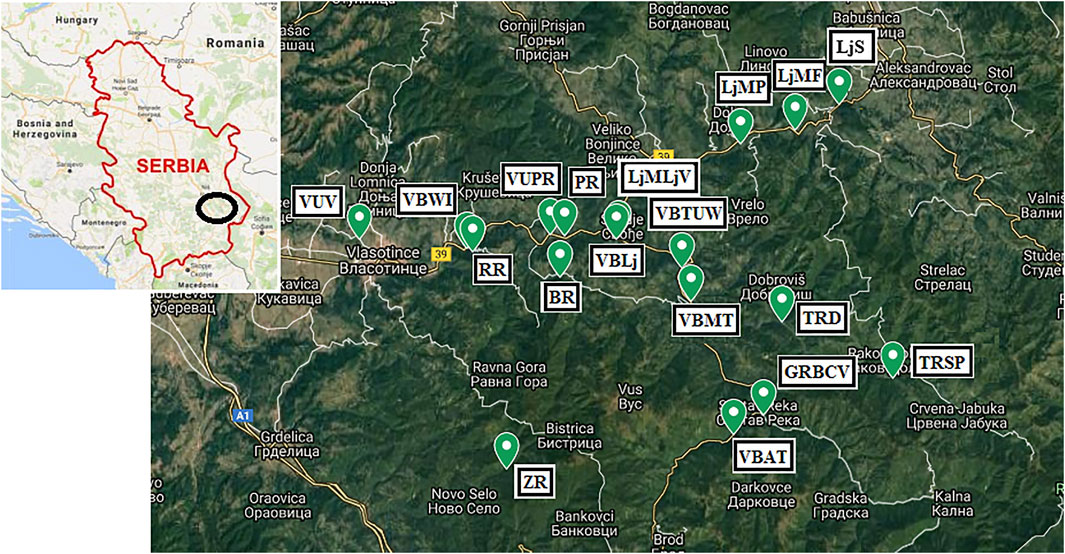
FIGURE 1. Sampling locations: VBAT—Vlasina (before receiving any tributary); GRBCV—Gradska river (before its confluence with Vlasina); VBMT—Vlasina (upstream of the confluence with Tegošnička river); TRSP—Tegošnička river (stone pit); TRD—Tegošnička river (near village Dobroviš); VBTUW—Vlasina (downstream of the confluence with Tegošnička river, near village Gornji Orah); LjMF—Ljuberađa (middle course); LjMP—Ljuberađa (measuring profile); LjMLjV—Ljuberađa, (confluence with Vlasina); VBLj—Vlasina (after receiving Ljuberađa); PR—Pusta river; VUPR—Vlasina (downstream of the confluence with Pusta river); BR—Bistrička river; RR—Rastavnica river; VBWI—Vlasina (upstream of the intake for water supply); VUV—Vlasina (downriver from Vlasotince); ZR—Zelenička river.
Water grab samples were collected at around 10 cm under the surface into the high-density polyethylene bottles. Samples were filtered through 0.2 μM nylon syringe filters, acidified with HNO3 to a pH below 2 and stored at 4°C until analysis (Thuong et al., 2015).
Sediment samples were collected with a plastic spatula (Sakan et al., 2007; Patel et al., 2018; Đorđević et al., 2021). Plastic shovels were used to collect sediment samples from shallow waters (Kemble et al., 1994), as well as to avoid metal contamination (Patel et al., 2018). After sampling, the sediment was packed in polyethylene bottles and transported to the laboratory. In the process of preparation for analysis, stones and plant debris were removed from the samples, and the precipitate was homogenized by mixing the sample with a plastic spoon in the laboratory. In this paper, we decided to work with air-dried samples, which is also recommended in the literature (Arain et al., 2008; Jamali et al., 2009). Samples were air dried for 8 days before analysis (Arain et al., 2008; Jamali et al., 2009).
Chemical Analysis
Sediment samples were analyzed by the optimized BCR (Community Bureau of Reference) three-step sequential extraction procedure (Passos et al., 2010; Sutherland 2010; Sakan et al., 2016). This manuscript considered results for the total amounts of the extracted elements. The total amounts of elements are defined as the sum of the element contents in the three fractions plus the aqua-regia extractable content of the residue (Facchinelli et al., 2001; Sakan et al., 2007). This method results in concentrations normally referred to as “pseudo-total,” “total extractable amount,” or “sequentially extractable amount,” as the silicates are not completely destroyed (Facchinelli et al., 2001).
Determination of Element Concentrations and Quality Control
Element concentrations in the water and extracts obtained at each of BCR extraction step were determined using techniques of Inductively Coupled Plasma—Optical Emission spectrometry (Thermo Scientific ICP-OES iCap 6500 Duo) and Inductively Coupled Plasma—Mass spectrometry (Thermo Scientific ICP-MS iCap Q). The analytical data quality was controlled by using laboratory quality assurance and quality control methods, including the use of standard operating procedures, calibration with standards, and analysis of both reagent blanks and replicates (Sakan et al., 2016). The blank solutions were prepared in the same way as the samples during the extraction procedure. Sediment data in this study are reported on a dry weight mg kg−1 basis.
The quality of data was assessed by estimations of accuracy and precision. The accuracy and precision of the obtained results were checked by analyzing sediment reference material (BCR 701) for three-step sequential extraction. Acceptable accuracy (80–120%) and precision (≤20%) of metals was achieved for all steps of sequential extraction (Supplementary Table S1).
Determination of Magnetic Susceptibility
Magnetic susceptibility (MS) was measured using a magnetic susceptibility meter SM30. This is a small device, which is highly sensitive and therefore can measure sediments and rocks with an extremely low level of magnetic susceptibility. Also, it is very important to note that it can distinctly measure diamagnetic materials such as limestone, quartz, and even water. The sensitivity of the SM30 device is 1 SI × 10–7 SI units, which is about 10 times better than the sensitivity of the majority of other instruments. It operates on frequency of 8 kHz, measurement time is less than 5 s, operating temperature is −20–50 °C. It has an 8 kHz LC oscillator with a large size pick-up coil as a sensor. The frequency of oscillation is measured when the coil is put on the surface of the measured sample and when the coil is removed tens of cm away from the sample.
To assure as much precise data as possible, each sample was measured in triplicate and the mean value was taken as the final result of measurement.
Statistical Analysis
In this study, principal component analysis (PCA) and cluster analysis (CA) were applied. PCA is an advanced algorithm for exploration of data that can identify patterns in the data structure and discover a transformed representation of data that highlights these patterns. Cluster analysis (CA) is an unsupervised pattern recognition approach that groups data/objects into clusters based on their similarities or dissimilarities. Correlation, principal component, and cluster analysis were performed using IBM SPSS 21 software.
Contamination Assessment Methods
In this manuscript, the index of geoaccumulation (Igeo) has been applied to assess the metal pollution in the sediment samples. This determination equation was introduced by Müller (1979). The equation used for the calculation of Igeo was as follows: Igeo = log2 (Cn/1.5 · Bn), where Cn—the measured concentration of heavy metals in the studied sediment and Bn—the geochemical background value. In this manuscript, element contents in soil from the Vlasina region were used as background values. Soil samples were collected near the river Vlasina and its tributaries. The data for soil content near the watercourses of Vlasina watershed, which were used for the calculations in this study, is shown in Sakan et al. (2021). Background contents of elements were calculated for each element as the 75th percentiles of the frequency distribution of the data—soil content (Dos Santos and Alleoni, 2013). The Igeo is typically divided into seven grades: Igeo < 0: uncontaminated/unpolluted; Igeo = (0–1): unpolluted/moderately; Igeo = (1–2): moderately; Igeo = (2–3): moderately/heavily; Igeo = (3–4): heavily; Igeo = (4–5): heavily/extremely and Igeo > 5: extremely. The factor 1.5 is the background matrix factor due to lithogenic effects (Haris et al., 2017).
Results and Discussion
Concentration of Studied Elements in Water and Water Quality
The concentration values of 21 elements (Zn, Ni, Cu, Cr, Pb, Cd, Al, B, Ba, Be, Ca, Co, Fe, K, Mg, Mn, Na, Sr, Ti, V, and As) in the water of rivers in the Vlasina region and detection limits are shown in Supplementary Table S2, while basic statistical parameters are shown in Table 3. The content of Hg in water was under the detection limit on all sampling sites.
The relative abundance of major metals in studied river waters was Ca > Mg > Na > K (Table 3, Supplementary Table S2). Regarding trace elements, concentrations of Pb, Cd, Ti, and B in all water samples were below the detection limits, and the mean concentrations of other trace elements decreased in the order of Sr > Ba > Al > Fe > As > Zn > Cu > V > Ni > Mn > Cr > Be > Co (Table 3, Supplementary Table S2).
The spatial distribution of elements regarding studied rivers is presented on maps produced by ArcGIS (Supplementary Figures S1–S3). Spatial variability was generally not very pronounced, although, similar spatial concentration patterns can be noticed for Ca, Mg, Sr and As with higher concentrations in Ljuberađa River and Tegošnička River, for K and V with higher concentrations in Tegošnička River, Ljuberađa River and in the most downriver samples of Vlasina River, for Fe, Mn, Cr with higher concentrations in the most downriver samples of Vlasina River, and for Ni and Cu with higher concentrations in Gradska River, Tegošnička River, Vlasina (after receiving Ljuberađa) and in the most downriver samples of Vlasina River (Supplementary Figures S1–S3; Supplementary Table S2).
Element concentrations in river water samples were compared with surface and drinking water quality standards and the results of other river water quality studies, as presented in Tables 3, 4. The concentrations of all measured regulated elements (Zn, Ni, Cu, Cr, Pb, Cd, Al, B, Ba, Be, Ca, Fe, K, Mg, Mn, Na, and As) in the investigated rivers of the Vlasina region were below recommended and prescribed limit values (Table 4).
Compared to less polluted rivers and rivers polluted by industrial discharges and mining activities in Serbia and the world (Table 3), element concentrations in this study were lower than those found in other studies.
Content of Studied Elements in Sediment and Comparison With Similar Results and Sediment Standards for Risk Elements
The content of 23 examined elements (Zn, Ni, Cu, Cr, Pb, Cd, Al, B, Ba, Be, Ca, Co, Fe, K, Mg, Mn, Na, Sr, Ti, V, As, Cd, Li) in sediments is shown in Supplementary Table 3 and Figure 2, while the mean, median, SD, minimum and maximum values of elements in the examined sediments are presented in Table 5. The content of Hg in river sediments was below the detection limit in all samples. The spatial distribution of studied elements for sediment is presented in Supplementary Figures S1–S4. Geochemical maps of the trace metals were created using ArcGIS. No significant spatial variability of potentially toxic elements in sediments was observed. The results of microelement content in studied river sediments decreased in the following order: Al > Mn > Ti > Zn > Ba > V > Cu > Ni > Cr > Li > As > Sr > Co > Pb > B > Be > Cd. The results of the mean content of macroelements in sediment were in order: Ca > Fe > Mg > Si > K > Na.
The total content of the studied elements, extracted from the sediments at the examined site, was compared with the limit and remediation values prescribed by the “Regulation on limit values for pollutants in surface and ground waters and sediments and the deadlines for their achievement” (Regulation—Government of the Republic of Serbia, 2012) for the preliminary risk assessment. In addition, the obtained results were also compared with sediment quality guidelines (SQGs) of the numerical indices: threshold effect concentration (TEC) and probable effect concentration (PEC). The TEC represents the concentration below which harmful effects are unlikely to be observed, and the PEC indicates the concentration above which harmful effects are likely to be observed. These values were used to assess the potential hazard to organisms with regard to the content of trace elements in the sediments using MacDonald et al. (2000). We also compared our results with the values for element concentrations in the continental crust (Wedepohl, 1995) and with similar results for river sediments in Serbia and the world.
The results of the comparison of toxic elements’ total extracted content with similar results for river sediments in Serbia and the world indicate that the contents of Zn, Ni, Cu, Cr, Pb, Cd, and As are much lower compared to the results from China, Serbia, and Dravinja (Slovenia). It was noticed that the contents of Cd and As in the sediments of Vlasina are similar to those in Dravinja. Mean values for As and maximum values for Ni are higher than TEC but lower than PEL values. The sediment samples with element concentrations between TEC and PEC values are potentially non-toxic, but the frequency of their toxicity occurrence is higher than for TEC values and yet lower than for PEC (MacDonald et al., 2000). The contents of Cd and As are higher than the average crust value; Cr and Ni are lower; while the contents of Zn, Cu, and Pb were similar to the crust contents. The Cr and Ni contents are lower than the crust values because the applied extraction agents do not completely destruct the silicates since hydrofluoric acid was not used. The slightly higher content of Cd and As in some sediments indicates the possible existence of additional sources of these elements in relation to geochemical processes in nature. Comparison of the contents of other examined elements (Table 5) with crust values indicates that the contents of Al, B, Ba, Be, Co, Fe, K, Li, and Na are mostly similar or slightly lower than the crust values, which is most likely due to incomplete destruction of silicates, while at some localities an increased content of Ca and Mg was observed, which indicates an increased content of carbonates in the examined localities.
The obtained results indicate that the contents of regulated toxic and potentially toxic elements in sediment samples are lower than the maximum allowable concentrations (Regulation—Government of the Republic of Serbia, 2012).
Correlation Analysis—Water
A correlation analysis was performed in order to examine the relationships between elements (Supplementary Table S4). At significance level 0.01, correlations were found between all major metals (Ca, K, Mg, Na), all major metals and V, and Ca and Sr with As. Regarding trace elements, correlations at significance level 0.01 were found for Ba-Ni and Ni-Cu. At significance level 0.05, correlations were found for the following pairs of trace elements: Ba-K, Ba-Cr, Ba-Mn, Cr-Mn, Cr-Ni, Mn-Ni, Ni-As (negative), Cu-As (negative).
Correlation Analysis—Sediment
The results of correlation analysis for the studied elements extracted from sediment are presented in Supplementary Table S5. The existence of positive correlations between most of the examined elements can be noticed, which may indicate their dominant geochemical origin. Of all the toxic elements, Pb stands out significantly, being the only one that is positively correlated with Cd, As, and Ba. Calcium is negatively correlated with elements that represent silicates (Al, Ti) and oxides (Fe, Mn), which is a consequence of the fact that they are competitive substrates. The existence of carbonate rocks has been shown in the studied area. Many elements show significant correlations with Mg, Li, Al, and Ti, but not with K. This could be an indication of magmatic rock presence in the studied area. According to elemental correlations, the most probable explanation is that present magmatic rocks are mostly acidic rocks, with prevailing albite and anorthite content, while sanidine (K,Na)Si3O8, orthoclase KSi3O8, and microcline KSi3O8 are most probably not present, or at least not in higher quantities. The highly positive correlation of Fe and Mn with trace elements indicates that Fe and Mn oxides/hydroxides play an important role in controlling the behavior of trace element pollution in sediments. Many authors have suggested that metals are efficiently adsorbed and co-precipitated with iron and manganese oxides/hydroxides (Al-Mur et al., 2017; Baran et al., 2019). All studied potentially toxic elements, except lead, were positively correlated with aluminum. The positive correlations of Al and Fe with PTEs in sediments indicate that these elements originate from lithogenic sources (Lima et al., 2022).
Correlation Analysis Between Mass Spectrometry and Studied Element Content in Sediment
The correlations between magnetic susceptibility (MS) and 23 studied elements in Vlasina sediments are presented in Table 6. As it can be seen, 10 elements show positive correlations while 13 elements show negative correlations with MS. None of the elements show very high correlation, which might be supported by our finding that Vlasina sediments are not under significant anthropogenic influence. That is, contrary to cases where significant anthropogenic influence was observed, like in the Kupa River drainage basin (Croatia), where very high positive correlations of MS with some elements exist (Frančišković-Bilinski et al., i2014, 2017; Sakan et al., 2020).
In Vlasina sediments highest positive correlations of MS are with V, Ti, Pb, Zn and a bit weaker correlations with Ba and Cu. Other elements have much weaker correlations with MS than these. It is known that reaction of V with cations of heavy metals, such as copper, lead, uranium, and zinc, forms epigenetic vanadate minerals in the oxidized zones of base-metal deposits (Kelley et al., 2017), so it could be assumed that this could be the natural source of these elements in the Vlasina region. Also, it is known that some altered titanium-rich syenite (igneous rock similar to granite) intrusions might contain high concentrations of vanadium, so this could explain MS correlations with V and Ti.
Principal Component Analysis—Water
Trace elements containing up to 10% of values below the detection limit (Ni, Cu, Cr, Mn, V, As) were included in PCA. The Kaiser–Meyer–Olkin (KMO) and the Bartlett sphericity tests were performed to examine the validity of PCA. The KMO value was 0.779 and the significant level of the Bartlett sphericity test was 0.02. In this study, as a result of PCA, initially 6 components were extracted. According to the Kaiser criterion, the first two components with initial eigenvalues larger than 1 were retained and subjected to varimax rotation. The results of PCA are shown in Table 7 and Figure 3A. Two components explained 69.78% of the total variance of the original data set (Table 7).
Component 1, which explained 47.61% of the total variance, had high positive loadings for Cr, Mn, Ni, and Cu, and moderate negative loadings for As (Table 7). As it can be noticed in Supplementary Table S4, significant positive correlations were found for Ni and Cu (r = 0.634, p < 0.01), Cr and Mn (r = 0.587, p < 0.05), Cr and Ni (r = 0.549, p < 0.05), and Mn and Ni (r = 0.559, p < 0.05). Also, As showed significant negative correlations with Cu (r = - 0.531, p < 0.05) and Ni (r = - 0.496, p < 0.05). Component 2 accounted for 22.16% of the total variance and had a high positive loading for V and a moderate positive loading for As.
The results of PCA suggest that different processes/sources contribute to concentrations of Cr, Mn, Ni, Cu, and also to concentrations of As and V in the studied waters.
Principal Component Analysis—Sediment
Principal component analysis showed that two principal components with an eigenvalue > 1 exist (Figure 3B; Table 8). Component 1 accounts for 70.049% of the variation and includes Ni, Zn, Cu, Cr, Cd, Co, and As. The obtained results suggested that these elements had a dominant geological source. Therefore, they may have been derived from natural processes such as soil erosion and rock weathering. This hypothesis is also supported by previous studies (Huang et al., 2020; Sakan et al., 2021). In Huang et al. (2020), it is shown that Cr, Ni, and Co may have derived from natural processes such as soil erosion and rock weathering. In Sakan et al. (2021), it is shown that the binding sites of microelements such as Co, Ni, Cr, and Cu in soils from the Vlasina region could be shales, as well as ultrabasites-basites and serpentinites. Erosive processes of various intensities affect most of the Vlasina River basin. The watercourses in the Vlasina basin are almost all torrents, and Tegošnica is among them. As a consequence of erosive processes and torrents, the soil is destroyed, which reduces its fertility and a huge amount of water is lost due to its sudden runoff.
Component 2 accounts for 15,183% of the variation and includes Pb, Cd, and As. The results show that the origin of lead is completely different in relation to the origin of Ni, Zn, Cu, Cr, and Co, while As and Cd are related to both components. It is possible to conclude that the content of Pb is mainly affected by human activities. Given that Cd and As are associated with both components, it is possible to assume that, in addition to the natural sources, anthropogenic sources of these elements are also important. Arsenic and cadmium are widely found in the environment (Perera et al., 2016). It can be found in the literature that use of agricultural chemicals has been indicated as the main anthropogenic source of As and Cd pollution in aquatic environments (Perera et al., 2016). Mickovski Stefanović (2012) showed that the sources of cadmium in the soil are mineral fertilizers, while lead and arsenic in general are derived from lead-arsenate (PbAsO4), which is used in orchards to control insects.
Cluster Analysis—Water
In the present study, hierarchical cluster analysis in the Q-mode (classification of sampling sites) was performed.
The results of cluster analysis (CA) are presented in a dendrogram in Figure 4. Samples were divided into three main groups–clusters which mostly differed in concentrations of As and Cu. Cluster 1 included samples of Tegošnička River, Ljuberađa River, samples of the Vlasina River downstream of each of these rivers and downstream of the Pusta River, and the Bistrička River. The majority of water samples in cluster 1 were characterized by higher concentrations of As than samples in cluster 2, and most of the samples had lower concentrations of Cu. Cluster 2 contained samples of the Vlasina River upstream of the confluence with the Tegošnička River, Gradska River, Pusta River, Rastavnica River, and the most downstream samples of the Vlasina River. These river water samples mainly had higher concentrations of Cu and lower concentrations of As, compared to samples in cluster 1. Cluster 3 comprised one sample, the Zelenička River, the only studied river that is not a tributary of the Vlasina River. With the exception of Ni, the Zelenička River is characterized by lower concentrations of trace elements.
Cluster Analysis—Sediment
A cluster analysis (CA) was performed to classify sampling sites in the Vlasina River watershed. All the sites were divided into three groups (Figure 5): group (1) includes all samples of Vlasina (UPR, BWI, UV, BTUW; BLj, BMT, and BAT), Rastavnica, Gradska River and Bistrička River; group (2) consists of the two subclusters: (2a) Tegošnička and Pusta River, and (2b) all three samples of Ljuberađa and group (3) includes one site, Zelenička River.
Group (1): In the samples that make up this group, i.e., cluster 1, no increased content of studied toxic elements was found. Considering that this group consists of all sediment samples from the Vlasina River and its three tributaries (Rastavnica, Gradska Reka, and Bistrička Reka), we can assume that the examined river sediments forming the first cluster have a similar geochemical composition and are not significantly exposed to anthropogenic pollution.
Group (2): in the samples of the Tegošnička River, an increased content of Zn, Ni, Cu, Cr, Pb, Cd, Co, As and Fe was observed in relation to other sediments, while an increased content of Fe was also observed in the Pusta River. An increased content of calcium was observed in the samples of Ljuberađa, which may be the reason for the separation of these samples from the others. In Perović (2019), it was shown that within the cracked and karstified limestones in the area of eastern Serbia, there are significant accumulations of groundwater, which are discharged through karst springs withvariable yield, and one of those springs is Ljuberađa. No increased content of other elements was noticed in the sediment samples from Ljuberađa. At the Tegošnička River site, one sample was taken near the quarry, which explains the grouping of these samples with Ljuberađa samples within the same cluster. The increased content of calcium that represents carbonates in certain sediments can be explained by the existence of tertiary clastic sediments and mesozoic carbonate rocks in the river basins, as shown in Durlević et al. (2019).
Group (3) is characterized by low concentrations of Ni, Cu, Cr, Co, and Fe, suggesting that most elements in sediments from the Zelenička River had a geological origin. The separation of this river into a special group indicates that this river differs significantly from Vlasina and other rivers in its basin in terms of geological and chemical composition.
Index of Geoaccumulation
The calculated Igeo values for Zn, Ni, Cu, Cr, Pb, Cd, and As are shown in Figure 6. The majority of investigated sediments were in class 0 (background concentration) with the exception of samples from the Tegošnička River (one sample is near the stone pit and the other sample is near the village Dobroviš) for As and Ni, which were in class 1 (unpolluted to moderately polluted). It has been shown in the literature (Smedley and Kinniburgh, 2001) that most common silicate minerals contain around 1 mg kg−1 or less As and carbonate minerals usually contain less than 10 mg kg−1. Since arsenic may be sorbed to the edges of clays and on the surface of calcite (Goldberg and Glaubig, 1988), higher mobility of arsenic can be expected in areas with high carbonate content. For nickel, process of adsorption on the calcite surface (Zachara et al., 1991) and coprecipitation with calcite (Alvarez 2019) was already described in literature. Lakshtanov and Stipp, (2007) reported that interaction of calcite with Ni controls its distribution in calcareous environments. Increased carbonate content in the Tegošnička River is expected given the nearby stone pit. In general, the values obtained for Igeo indicate that the sediments in the Vlasina region were uncontaminated regarding the studied elements. Negative Igeo values for most soils indicated that there was no contamination. Therefore, the origin of elements is mostly from natural processes such as soil and rock weathering.
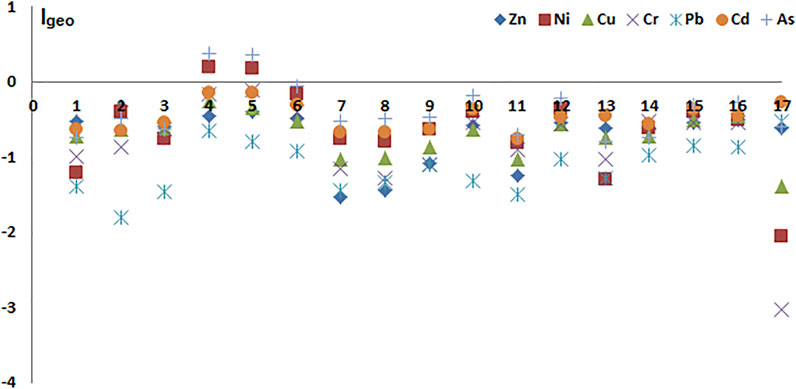
FIGURE 6. Distribution of studied elements enrichment based on Igeo in sediment: 1—Vlasina (before receiving any tributary); 2—Gradska river (before its confluence with Vlasina); 3—Vlasina (upstream of the confluence with Tegošnička river); 4—Tegošnička river (stone pit); 5—Tegošnička river (near village Dobroviš); 6—Vlasina (downstream of the confluence with Tegošnička river, near village Gornji Orah); 7—Ljuberađa (middle course); 8—Ljuberađa (measuring profile); 9—Ljuberađa, (confluence with Vlasina); 10—Vlasina (after receiving Ljuberađa); 11—Pusta river; 12—Vlasina (downstream of the confluence with Pusta river); 13—Bistrička river); 14—Rastavnica river; 15—Vlasina (upstream of the intake for water supply); 16—Vlasina (downriver from Vlasotince); 17—Zelenička river.
Conclusion
In this study, the water and sediments of rivers in the Vlasina region were analyzed to assess the current state of pollution with toxic elements. No significant spatial variability of potentially toxic elements in water and sediments was observed.
The concentrations of all measured regulated elements in the investigated rivers of the Vlasina region were below recommended and prescribed limit values. Differences in the distribution of some elements in water and sediment are a consequence of the fact that the water samples constitute a snapshot of chemicals in the water, while surface sediments retain longer-term records.
The existence of positive correlations between most of the examined elements in sediments may indicate their dominant geochemical origin. The positive correlations of Al and Fe with PTEs in sediments indicate that these elements originate from lithogenic sources. The obtained results showed the great importance of carbonates for the mobility and binding of As and Ni in environments with increased calcium and magnesium content.
The results of PCA suggest that different processes/sources contribute to concentrations of Cr, Mn, Ni, Cu, and also to concentrations of As and V in the studied waters. Based on the obtained PCA results for sediments, it is possible to conclude that Ni, Zn, Cu, Cr, Cd, Co, and As had a dominant geological source, and the origin of lead is completely different in relation to the other elements. Since As and Cd are related to both components, it can be assumed that, in addition to natural, anthropogenic sources of these elements are also important.
In general, the values obtained for Igeo indicate that the sediments in the Vlasina region were uncontaminated regarding the studied elements. Negative Igeo values for most sediments indicated that there was no contamination. The results of magnetic susceptibility support our finding that Vlasina sediments are not under significant anthropogenic influence.
The obtained results confirmed the assumption that the Vlasina is one of the cleanest rivers in Serbia, as well as its tributaries. In view of this, as well as the major problems that exist with the pollution of river flows, all necessary measures should be taken to protect this river, as well as to continue monitoring the status of pollution in these river systems.
The combination of chemometric approaches and pollution indices is useful for assessment of the pollution status of toxic elements, but magnetic susceptibility measurement is better for more polluted areas.
Data Availability Statement
The original contributions presented in the study are included in the article/Supplementary Material; further inquiries can be directed to the corresponding author.
Author Contributions
All the authors listed have made a substantial, direct, and intellectual contribution to the work and approved it for publication.
Funding
The authors would like to thank the Ministry of Education, Science and Technological Development of the Republic of Serbia (Grant No: 451-03-68/2022-14/200026) for financial support.
Conflict of Interest
The authors declare that the research was conducted in the absence of any commercial or financial relationships that could be construed as a potential conflict of interest.
Publisher’s Note
All claims expressed in this article are solely those of the authors and do not necessarily represent those of their affiliated organizations, or those of the publisher, the editors, and the reviewers. Any product that may be evaluated in this article, or claim that may be made by its manufacturer, is not guaranteed or endorsed by the publisher.
Supplementary Material
The Supplementary Material for this article can be found online at: https://www.frontiersin.org/articles/10.3389/fenvs.2022.909858/full#supplementary-material
References
Al-Mur, B. A., Quicksall, A. N., and Al-Ansari, A. M. A. (2017). Spatial and Temporal Distribution of Heavy Metals in Coastal Core Sediments from the Red Sea, Saudi Arabia. Oceanologia 59 (3), 262–270. doi:10.1016/j.oceano.2017.03.003
Alvarez, M. C. C. (2019). Nickel Isotope Fractionation during Adsorption on the Calcite Surface and Coprecipitation with Calcite. Mineralogy. [dissertation thesis]. Toulouse: Université Paul Sabatier. [Toulouse III], English. NNT : 2019TOU30047.
Arain, M. B., Kazi, T. G., Jamali, M. K., Jalbani, N., Afridi, H. I., and Baig, J. A. (2008). Speciation of Heavy Metals in Sediment by Conventional, Ultrasound and Microwave Assisted Single Extraction Methods: A Comparison with Modified Sequential Extraction Procedure. J. Hazard. Mater. 154, 998–1006. doi:10.1016/j.jhazmat.2007.11.004
Baran, A., Tarnawski, M., Koniarz, T., and Szara, M. (2019). Content of Nutrients, Trace Elements, and Ecotoxicity of Sediment Cores from Rożnów Reservoir (Southern Poland). Environ. Geochem. Health 41, 2929–2948. doi:10.1007/s10653-019-00363-x
Carrillo, K. C., Drouet, J. C., Rodríguez-Romero, A., Tovar-Sánchez, A., Ruiz-Gutiérrez, G., and Viguri Fuente, J. R. (2021). Spatial Distribution and Level of Contamination of Potentially Toxic Elements in Sediments and Soils of a Biological Reserve Wetland, Northern Amazon Region of Ecuador. J. Environ. Manag. 289, 112495. doi:10.1016/j.jenvman.2021.112495
Čvoro, J., and Golubović, P. (2001). Geography of Yugoslavia. Niš: University of Niš, Faculty of Science.
Dević, G., Sakan, S., and Đorđević, D. (2016). Assessment of the Environmental Significance of Nutrients and Heavy Metal Pollution in the River Network of Serbia. Environ. Sci. Pollut. Res. 23, 282–297. doi:10.1007/s11356-015-5808-5
Đorđević, D., Sakan, S., Trifunović, S., Škrivanj, S., and Finger, D. (2021). Element Content in Volcano Ash, Soil and River Sediments of the Watershed in the Volcanic Area of South Iceland and Assessment of Their Mobility Potential. Water 13, 1928. doi:10.3390/w13141928
Dos Santos, S. N., and Alleoni, L. R. F. (2013). Reference Values for Heavy Metals in Soils of the Brazilian Agricultural Frontier in Southwestern Amazônia. Environ. Monit. Assess. 185, 5737–5748. doi:10.1007/s10661-012-2980-7
Durlevic, U., Momcilovic, A., Curic, V., and Dragojevic, M. (2019). Gis Application in Analysis of Erosion Intensity in the Vlasina River Basin. B Serbian Geogr. 99 (2), 17–36. doi:10.2298/gsgd1902017d
European Commission (2013). Directive 2013/39/EU of the European Parliament and of the Council of 12 August 2013 Amending Directives 2000/60/EC and 2008/105/EC as Regards Priority Substances in the Field of Water Policy. Off. J. Eur. Union L226, 1–17.
European Commission (2020). Directive (EU) 2020/2184 of the European Parliament and of the Council of 16 December 2020 on the Quality of Water Intended for Human Consumption. Off. J. Eur. Union, L 435, 1–62.
Facchinelli, A., Sacchi, E., and Mallen, L. (2001). Multivariate Statistical and GIS-Based Approach to Identify Heavy Metal Sources in Soils. Environ. Pollut. 114, 313–324. doi:10.1016/s0269-7491(00)00243-8
Frančišković-Bilinski, S., Bilinski, H., Scholger, R., Tomašić, N., and Maldini, K. (2014). Magnetic Spherules in Sediments of the Karstic Dobra River (Croatia). J. Soils Sediments 14, 600–614. doi:10.1007/s11368-013-0808-x
Frančišković-Bilinski, S., Bilinski, H., Maldini, K., Milović, S., Zhang, Q., and Appel, E. (2017). Chemical and Magnetic Tracing of Coal Slag Pollutants in Karstic River Sediments. Environ. Earth Sci. 76, 476. doi:10.1007/s12665-017-6792-5
GLP (2012). General Regulation Plan for the Settlement of Vlasina Stojkovićeva. Surdulica: Municipal Administration of the Municipality of Surdulica.
Goldberg, S., and Glaubig, R. A. (1988). Anion Sorption on a Calcareous, Montmorillonitic Soil-Arsenic. Soil Sci. Soc. Am. J. 52, 1297–1300. doi:10.2136/sssaj1988.03615995005200050015x
Government of Republic of Serbia (2012). Regulation on Limit Values for Pollutants in Surface and Ground Waters and Sediments and the Deadlines for Their Achievement. Off. Gaz. Rep. Serbia No 50/12.
Government of Republic of Serbia (2014). Regulation on Limit Values for Priority and Priority Hazardous Substances that Pollute the Surface Waters and Deadlines for Their Achievement. Off. Gaz. Rep. Serbia No 24/14.
Government of Republic of Serbia (2019). Regulation on Hygienic Quality of Drinking Water. Off. Gaz. Rep. Serbia No 42/98, 44/99 and 28/19.
Hans Wedepohl, K. (1995). The Composition of the Continental Crust. Geochimica Cosmochimica Acta 59, 1217–1232. doi:10.1016/0016-7037(95)00038-2
Haris, H., Looi, L. J., Aris, A. Z., Mokhtar, N. F., Ayob, N. A. A., Yusoff, F. M., et al. (2017). Geo-accumulation Index and Contamination Factors of Heavy Metals (Zn and Pb) in Urban River Sediment. Environ. Geochem. Health 39, 1259–1271. doi:10.1007/s10653-017-9971-0
Huang, Z., Liu, C., Zhao, X., Dong, J., and Zheng, B. (2020). Risk Assessment of Heavy Metals in the Surface Sediment at the Drinking Water Source of the Xiangjiang River in South China. Environ. Sci. Eur. 32, 23. doi:10.1186/s12302-020-00305-w
Jahan, S., and Strezov, V. (2018). Comparison of Pollution Indices for the Assessment of Heavy Metals in the Sediments of Seaports of NSW, Australia. Mar. Pollut. Bull. 128, 295–306. doi:10.1016/j.marpolbul.2018.01.036
Jamali, M. K., Kazi, T. G., Arain, M. B., Afridi, H. I., Jalbani, N., Kandhro, G. A., et al. (2009). Speciation of Heavy Metals in Untreated Sewage Sludge by Using Microwave Assisted Sequential Extraction Procedure. J. Hazard. Mater. 163, 1157–1164. doi:10.1016/j.jhazmat.2008.07.071
Kasalica, V., Jovanović, J., and Bojić, Z. (2021). Annual Report on the Annex to the Project Mineragenetic Characteristics and Potential of the Neogene Basins of Serbia for 2021. Republic of Serbia, Geologocal Survey of Serbia. Belgrade, Serbia.
Kelley, K. D., Scott, C., Polyak, D. E., and Kimball, B. E. (2017). in Critical Mineral Resources of the United States—Economic and Environmental Geology and Prospects for Future Supply. Editors K. J. Vanadium, J. H. DeYoungJr., R. R. Seal, and D. C. Bradley (Reston, Virginia: U.S. Geological Survey Professional Paper 1802), U1–U36. March Accessed 02, 2022). doi:10.3133/pp1802U
Kemble, N. E., Brumbaugh, W. G., Brunson, E. L., Dwyer, F. J., Ingersoll, C. G., Monda, D. P., et al. (1994). Toxicity of Metal-Contaminated Sediments From the Upper Clark Fork River, Montana to Aquatic Invertebrates and Fish in Laboratory Exposures. Environ. Toxicol. Chem. 13, 1985–1997. doi:10.1016/j.envpol.2014.10.014
Lakshtanov, L. Z., and Stipp, S. L. S. (2007). Experimental Study of Nickel(II) Interaction with Calcite: Adsorption and Coprecipitation. Geochimica Cosmochimica Acta 71, 3686–3697. doi:10.1016/j.gca.2007.04.006
Lima, M. W. d., Pereira, W. V. d. S., Souza, E. S. d., Teixeira, R. A., Palheta, D. d. C., Faial, K. d. C. F., et al. (2022). Bioaccumulation and Human Health Risks of Potentially Toxic Elements in Fish Species from the Southeastern Carajás Mineral Province, Brazil. Environ. Res. 204, 112024. doi:10.1016/j.envres.2021.112024
Looi, L. J., Aris, A. Z., Wan Johari, W. L., Md. Yusoff, F., and Hashim, Z. (2013). Baseline Metals Pollution Profile of Tropical Estuaries and Coastal Waters of the Straits of Malacca. Mar. Pollut. Bull. 74, 471–476. doi:10.1016/j.marpolbul.2013.06.008
MacDonald, D. D., Ingersoll, C. G., and Berger, T. A. (2000). Development and Evaluation of Consensus-Based Sediment Quality Guidelines for Freshwater Ecosystems. Archives Environ. Contam. Toxicol. 39, 20–31. doi:10.1007/s002440010075
Marjanović, T. D. (2000). Vlasina Basin (Natural Features, Water Management Problems and the Idea for Their Solution). Vlasotince: Informativni list Vlasina, 3–76.
Mezga, K., Dolenec, M., Šram, D., and Vrhovnik, P. (2021). Potentially Toxic Elements in the Dravinja River Sediments7 (Eastern Slovenia). Geol 35 (2), 141–150. doi:10.46763/geol21352141m
Mickovski Stefanović, V. Ž. (2012). The Impact of Genotype and Locality on the Dynamic of Accumulation Heavy Metals in Wheat Vegetative Organs. [dissertation thesis]. Belgrade (Serbia): University of Belgrade.
Mihajlidi-Zelić, A., Đorđević, D., Relić, D., Tošić, I., Ignjatović, Lj., Stortini, M. A., et al. (2015). Water-soluble Inorganic Ions in Urban Aerosols of the Continental Part of Balkans (Belgrade) during the Summer - Autumn (2008). Open Chem. 13 (1), 245–256. doi:10.1515/chem-2015-0010
Müller, G. (1979). Schwermetalle in den Sedimenten des RheinsVera¨nderungen seit 1971. Umschau 79, 778–783.
Olías, M., Cánovas, C. R., Macías, F., Basallote, M. D., and Nieto, J. M. (2020). The Evolution of Pollutant Concentrations in a River Severely Affected by Acid Mine Drainage: Río Tinto (SW Spain). Minerals 10, 598. doi:10.3390/min10070598
Passos, E. d. A., Alves, J. C., dos Santos, I. S., Alves, J. d. P. H., Garcia, C. A. B., and Spinola Costa, A. C. (2010). Assessment of Trace Metals Contamination in Estuarine Sediments Using a Sequential Extraction Technique and Principal Component Analysis. Microchem. J. 96, 50–57. doi:10.1016/j.microc.2010.01.018
Patel, P., Raju, N. J., Reddy, B. C. S. R., Suresh, U., Sankar, D. B., and Reddy, T. V. K. (2018). Heavy Metal Contamination in River Water and Sediments of the Swarnamukhi River Basin, India: Risk Assessment and Environmental Implications. Environ. Geochem. Health 40, 609–623. doi:10.1007/s10653-017-0006-7
Peré-Trepat, E., Olivell, L., Ginebreda, A., Caixach, J., and Tauler, R. (2006). Chemometrics Modelling of Organic Contaminants in Fish and Sediment River Samples. Sci. Tot. Environ. 371, 223–237. doi:10.1016/j.scitotenv.2006.04.005
Perera, P. C. T., Sundarabarathy, T. V., Sivananthawerl, T., Kodithuwakku, S. P., and Edirisinghe, U. (2016). Arsenic and Cadmium Contamination in Water, Sediments and Fish Is a Consequence of Paddy Cultivation: Evidence of River Pollution in Sri Lanka. Achiev. Life Sci. 10, 144–160. doi:10.1016/j.als.2016.11.002
Perović, M. (2019). Impact Assessment and Regional Specificities of Hydrogeochemical Conditions on the Transformation of Nitrogenous Compounds in Groundwater. [dissertation thesis]. Novi Sad (Serbia): University of Novi Sad.
Radomirović, M., Ćirović, Ž., Maksin, D., Bakić, T., Lukić, J., Stanković, S., et al. (2020). Ecological Risk Assessment of Heavy Metals in the Soil at a Former Painting Industry Facility. Front. Environ. Sci. 8, 560415. doi:10.3389/fenvs.2020.560415
Radomirović, M., Mijatović, N., Vasić, M., Tanaskovski, B., Mandić, M., Pezo, L., et al. (2021). The Characterization and Pollution Status of the Surface Sediment in the Boka Kotorska Bay, Montenegro. Environ. Sci. Pollut. Res. 28, 53629–53652. doi:10.1007/s11356-021-14382-8
Rodríguez, M. J. A., De Arana, C., Ramos-Mir, J. J., Gil, C., and Boluda, R. (2015). Impact of 70 Years Urban Growth Associated With Heavy Metal Pollution. Environ. Pollut. 196, 156–163. doi:10.1016/j.envpol.2014.10.014
Sakan, S., Gržetić, I., and Đorđević, D. (2007). Distribution and Fractionation of Heavy Metals in the Tisa (Tisza) River Sediments. Env. Sci. Poll. Res. Int. 14 (4), 229–236. doi:10.1065/espr2006.05.304
Sakan, S. M., Đorđević, D. S., Manojlović, D. D., and Predrag, P. S. (2009). Assessment of Heavy Metal Pollutants Accumulation in the Tisza River Sediments. J. Environ. Manag. Manage. 90, 3382–3390. doi:10.1016/j.jenvman.2009.05.013
Sakan, S., Đorđević, D., Dević, G., Relić, D., Anđelković, I., and Ðuričić, J. (2011). A Study of Trace Element Contamination in River Sediments in Serbia Using Microwave-Assisted Aqua Regia Digestion and Multivariate Statistical Analysis. Microchem. J. 99 (2), 492–502. doi:10.1016/j.microc.2011.06.027
Sakan, S., Popović, A., Anđelković, I., and Đorđević, D. (2016). Aquatic Sediments Pollution Estimate Using the Metal Fractionation, Secondary Phase Enrichment Factor Calculation, and Used Statistical Methods. Environ. Geochem. Health 38, 855–867. doi:10.1007/s10653-015-9766-0
Sakan, S., Sakan, N., Anđelković, I., Trifunović, S., and Đorđević, D. (2017). Study of Potential Harmful Elements (Arsenic, Mercury and Selenium) in Surface Sediments from Serbian Rivers and Artificial Lakes. J. Geochem. Explor. 180, 24–34. doi:10.1016/j.gexplo.2017.06.006
Sakan, S., Frančišković-Bilinski, S., Đorđević, D., Popović, A., Škrivanj, S., and Bilinski, H. (2020). Geochemical Fractionation and Risk Assessment of Potentially Toxic Elements in Sediments from Kupa River, Croatia. Water 12, 2024. doi:10.3390/w12072024
Sakan, S., Mihajlidi Zelić, A., Škrivanj, S., Frančišković Bilinski, S., Bilinski, H., and Đorđević, D. (2021). “Toxic Elements in Soils from Vlasina Region,” in Proceeding of the 3rd International and 15th National Congress Soils for Future Under Global Challenges, Sokobanja, Serbia, September 2021 (Belgrade: Serbian Society of Soil Science, Book of Proceedings), 79–86.
Simić, M. (2001). Metallogeny of Mačkatica-Blagodat-Karamanica Zone. Belgrade: Geo Institute, Special Editions of, Book 28. (in Serbian).
Savić, M. (2019). Regional-geographical Overview of Vlasina and Krajina. [master work]. Niš (Serbia): University of Niš.
Smedley, P. L., and Kinniburgh, D. G. (2001). Source and Behaviour of Arsenic in Natural Waters. Wallingford, Oxon OX10 8BB, U.K: British Geological Survey. Available from: https://www.Source_and_behaviour_of_arsenic_in_natur.pdf (Accessed March 03, 2022).[
Sutherland, R. A. (2010). BCR-701: A Review of 10-years of Sequential Extraction Analyses. Anal. Chim. Acta 680, 10–20. doi:10.1016/j.aca.2010.09.016
Thuong, N. T., Yoneda, M., Ikegami, M., and Takakura, M. (2013). Source Discrimination of Heavy Metals in Sediment and Water of to Lich River in Hanoi City Using Multivariate Statistical Approaches. Environ. Monit. Assess. 185, 8065–8075. doi:10.1007/s10661-013-3155-x
Thuong, N. T., Yoneda, M., Shimada, Y., and Matsui, Y. (2015). Assessment of Trace Metal Contamination and Exchange between Water and Sediment Systems in the to Lich River in Inner Hanoi, Vietnam. Environ. Earth Sci. 73, 3925–3936. doi:10.1007/s12665-014-3678-7
USEPA (2022). National Primary Drinking Water Regulations. Available from: https://www.epa.gov/ground-water-and-drinking-water/national-primary-drinking-water-regulations#Inorganic (Accessed March 27, 2022).
Ustaoğlu, F. (2021). Ecotoxicological Risk Assessment and Source Identification of Heavy Metals in the Surface Sediments of Çömlekci Stream, Giresun, Turkey. Environ. Forensics 22, 130–142. doi:10.1080/15275922.2020.1806148
Ustaoğlu, F., and Islam, M. S. (2020). Potential Toxic Elements in Sediment of Some Rivers at Giresun, Northeast Turkey: A Preliminary Assessment for Ecotoxicological Status and Health Risk. Ecol. Indic. 113, 106237. doi:10.1016/j.ecolind.2020.106237
Ustaoğlu, F., Tepe, Y., and Aydin, H. (2020). Heavy Metals in Sediments of Two Nearby Streams from Southeastern Black Sea Coast: Contamination and Ecological Risk Assessment. Environ. Forensics 21, 145–156. doi:10.1080/15275922.2020.1728433
Varol, M., Karakaya, G., and Sünbül, M. R. (2021). Spatiotemporal Variations, Health Risks, Pollution Status and Possible Sources of Dissolved Trace Metal(loid)s in the Karasu River, Turkey. Environ. Res. 202, 111733. doi:10.1016/j.envres.2021.111733
Wang, J., Liu, G., Liu, H., and Lam, P. K. S. (2017). Multivariate Statistical Evaluation of Dissolved Trace Elements and a Water Quality Assessment in the Middle Reaches of Huaihe River, Anhui, China. Sci. Total Environ. 583, 421–431. doi:10.1016/j.scitotenv.2017.01.088
Wang, X., Shi, Z., Shi, Y., Ni, S., Wang, R., Xu, W., et al. (2018). Distribution of Potentially Toxic Elements in Sediment of the Anning River Near the REE and V-Ti Magnetite Mines in the Panxi Rift, SW China. J. Geochem. Explor. 184, 110–118. doi:10.1016/j.gexplo.2017.10.018
WHO (2017). Guidelines for Drinking-Water Quality: Fourth Edition Incorporating the First Addendum. Geneva: World Health Organization.
Yüksel, B., Ustaoğlu, F., Tokatli, C., and Islam, M. S. (2021). Ecotoxicological Risk Assessment for Sediments of Çavuşlu Stream in Giresun, Turkey: Association between Garbage Disposal Facility and Metallic Accumulation. Environ. Sci. Pollut. Res. 29, 17223–17240. doi:10.1007/s11356-021-17023-2
Keywords: Vlasina river, trace elements, spatial distribution, chemometric methods, pollution, surface water, integrated approach
Citation: Sakan S, Mihajlidi-Zelić A, Škrivanj S, Frančišković-Bilinski S and Đorđević D (2022) An Integrated Approach in the Assessment of the Vlasina River System Pollution by Toxic Elements. Front. Environ. Sci. 10:909858. doi: 10.3389/fenvs.2022.909858
Received: 31 March 2022; Accepted: 29 April 2022;
Published: 14 June 2022.
Edited by:
Antonije Onjia, University of Belgrade, SerbiaReviewed by:
Dejan Krčmar, University of Novi Sad, SerbiaFikret Ustaoğlu, Giresun University, Turkey
Snezana Dragovic, University of Belgrade, Serbia
Copyright © 2022 Sakan, Mihajlidi-Zelić, Škrivanj, Frančišković-Bilinski and Đorđević. This is an open-access article distributed under the terms of the Creative Commons Attribution License (CC BY). The use, distribution or reproduction in other forums is permitted, provided the original author(s) and the copyright owner(s) are credited and that the original publication in this journal is cited, in accordance with accepted academic practice. No use, distribution or reproduction is permitted which does not comply with these terms.
*Correspondence: Sanja Sakan, c3Nha2FuQGNoZW0uYmcuYWMucnM=, c2FuamEuc2FrYW5AaWh0bS5iZy5hYy5ycw==
 Sanja Sakan
Sanja Sakan Aleksandra Mihajlidi-Zelić
Aleksandra Mihajlidi-Zelić Sandra Škrivanj2
Sandra Škrivanj2 Dragana Đorđević
Dragana Đorđević